Are We Adapting to Climate Change? Evidence from the High-Quality Agri-Food Sector in the Veneto Region
Abstract
:1. Introduction
2. Conceptual Tangles: Types of Adaptations in Agriculture
3. Materials and Methods
3.1. Climate Change and Interannual Climate Variability in the Veneto Region
3.2. Data: The Subsample of Agri-Food GIs
- Asparago Bianco di Bassano (asparagus);
- Ciliegia di Marostica (cherry);
- Fagiolo di Lamon (bean);
- Monte Veronese (cheese);
- Radicchio di Chioggia (chicory);
- Radicchio Rosso di Treviso (chicory);
- Riso Nano Vialone Veronese (rice);
- Olio Veneto (olive oil);
- Casatella Trevigiana (cheese);
- Piave (cheese);
- Marrone di San Zeno (chestnut).
3.3. Method
3.3.1. Semi-Structured Interviews
3.3.2. Focus Group Discussions
3.3.3. Data Analysis
4. Results
4.1. Climate Change Observations and Their Effects on the GI Systems
“Last years, there have been some calamitous events, such as persistent rains and storms, which greatly penalized the production of local forages”. [IAB06]
“There are some new diseases; we have been able to control some of them. But everything is in the norm, there aren’t these big weird problems… I don’t see the damages to blame climate change.” [IPC14]
“Defending the GI product means defending the farmers, and also defending the territory. If people work and make money here, they will stay. If people close everything, they will leave the territory”. [IPC02]
4.2. Emerging Practices of Adaptation to Climate Change
4.2.1. Adaptation at Farm Level
4.2.2. Adaptation at the GI Level
5. Discussion
5.1. Barriers to Adaptation
5.1.1. Behavioral Barriers
5.1.2. Socioeconomic Barriers
5.1.3. Policy- and Governance-Related Barriers
5.1.4. Information Barriers
5.1.5. Structural Barriers
5.2. Policy Recommendations
6. Conclusions
Author Contributions
Funding
Institutional Review Board Statement
Informed Consent Statement
Data Availability Statement
Acknowledgments
Conflicts of Interest
Appendix A
- Introduction
- -
- Could you please tell us about your association/consortium/company?
- -
- Who are your associates and how does the collaboration among them take place?
- Observations of climate change and its effects on GI production
- -
- What is your opinion on the potential and current effects of climate change on the production of GIs in the Veneto Region?
- -
- In your opinion, which GI is the most vulnerable one, due to climate change?
- Adaptation measures to climate change
- -
- What are the measures that farmers/producers have introduced to adapt to the effects of climate change?
- Governance and coordination
- -
- Have the Consortia or producer organizations put in place collective mitigation/adaptation strategies?
- Barriers and the role of public incentives and policies
- -
- In your opinion, which are the main barriers to adaptation/mitigation?
- -
- What could help GIs to adapt and mitigate the risks deriving from climate change?
- -
- What is the role of economic incentives (e.g., in the field of the CAP) in the mitigation of risks and adaptation of GI production to climate change?
- Ending questions
Appendix B
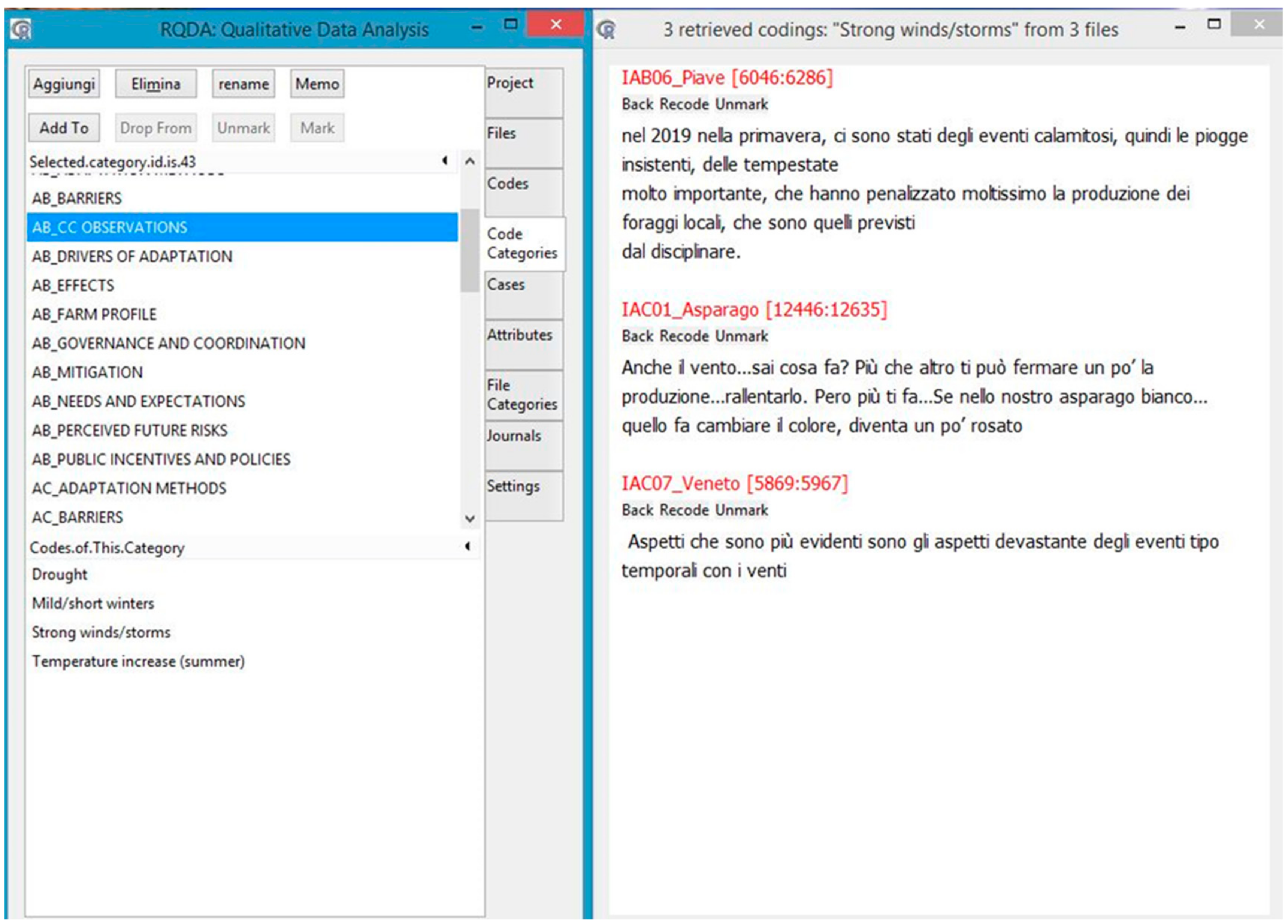
References
- EEA (European Environmental Agency). Climate Change Adaptation in the Agriculture Sector in Europe; EAA Report; EAA: Luxembourg, 2019; pp. 1–108. Available online: https://www.eea.europa.eu/publications/cc-adaptation-agriculture/#page=80 (accessed on 20 June 2022).
- Food and Agriculture Organisation (FAO). The Impact of Disasters and Crises on Agriculture and Food Security; FAO: Rome, Italy, 2021. [Google Scholar] [CrossRef]
- Touzard, J.-M.; Temple, L.; Guy, F.; Bernard, T. Innovation Systems and Knowledge Communities in the Agriculture and Agrifood Sector: A Literature Review. J. Innov. Econ. Manag. 2015, 17, 117–142. [Google Scholar] [CrossRef]
- Beltrán-Tolosa, L.M.; Navarro-Racines, C.; Pradhan, P.; Cruz-Garcia, G.S.; Solis, R.; Quintero, M. Action needed for staple crops in the Andean-Amazon foothills because of climate change. Mitig. Adapt. Strateg. Glob. Chang. 2020, 25, 1103–1127. [Google Scholar] [CrossRef]
- Asayehegn, K.; Temple, L.; Sanchez, B.; Iglesias, A. Perception of climate change and farm level adaptation choices in central Kenya. Cah. Agric. 2017, 26, 25003. [Google Scholar] [CrossRef]
- Funk, C.; Raghavan, S.A.; Winker, P.; Breuer, L. Changing climate-Changing livelihood: Smallholder’s perceptions and adaption strategies. J. Env. Manag. 2020, 259, 109702. [Google Scholar] [CrossRef] [PubMed]
- Ahmed, Z.; Guha, G.S.; Shew, A.M.; Alam, G.M. Climate change risk perceptions and agricultural adaptation strategies in vulnerable riverine char islands of Bangladesh. Land Use Policy 2021, 103, 105295. [Google Scholar] [CrossRef]
- Belete, Y.; Shimelis, H.; Laing, M. Wheat Production in Drought-Prone Agro-Ecologies in Ethiopia: Diagnostic Assessment of Farmers’ Practices and Sustainable Coping Mechanisms and the Role of Improved Cultivars. Sustainability 2022, 14, 7579. [Google Scholar] [CrossRef]
- Megersa, G.G.; Jaleta, M.; Tesfaye, K.; Getnet, M.; Tana, T.; Lakew, B. Perceived Climate Change and Determinants of Adaptation Responses by Smallholder Farmers in Central Ethiopia. Sustainability 2022, 14, 6590. [Google Scholar] [CrossRef]
- Clark, L.; Kerr, W. Climate change and terroir: The challenge of adapting geographical indications. J. World Intel Prop. 2017, 20, 88–102. [Google Scholar] [CrossRef]
- Quiñones-Ruiz, X.; Edelmann, H.; Penker, M.; Belletti, G.; Marescotti, A.; Scaramuzzi, S.; Broscha, K.; Braito, M.; Altenbuchner, C. How are food Geographical Indications evolving?–An analysis of EU GI amendments. British Food J. 2018, 120, 1876–1887. [Google Scholar] [CrossRef]
- Moriondo, M.; Jones, G.V.; Bois, B.; Dibari, C.; Ferrise, R.; Trombi, G.; Bindi, M. Projected shifts of wine regions in response to climate change. Clim. Chang. 2013, 119, 825–839. [Google Scholar] [CrossRef]
- Hewer, M.; Brunette, M. Climate change impact assessment on grape and wine for Ontario, Canada’s appellations of origin. Reg. Environ. Chang. 2022, 20, 86. [Google Scholar] [CrossRef]
- Conca Messina, S.A.; Le Bras, S.; Tedeschi, P.; Piñeiro, M.V. Terroir, Institutions and Improvements in European Wine History: An Introduction. In A History of Wine in Europe, 19th to 20th Centuries, Volume II. Palgrave Studies in Economic History; Conca Messina, S., Le Bras, S., Tedeschi, P., Vaquero Piñeiro, M., Eds.; Palgrave Macmillan: Cham, Switzerland, 2019. [Google Scholar] [CrossRef]
- Fuhrer, J.; Smith, P.; Gobiet, A. Implications of climate change scenarios for agriculture in alpine regions—A case study in the swiss rhone catchment. Sci. Total Environ. 2014, 493, 1232–1241. [Google Scholar] [CrossRef] [PubMed]
- IPCC. Annex II: Glossary [Mach, K.J., S. Planton and C. von Stechow (eds.)]. In Climate Change 2014: Synthesis Report. Contribution of Working Groups I, II and III to the Fifth Assessment Report of the Intergovernmental Panel on Climate Change; Core Writing Team, Pachauri, R.K., Meyer, L.A., Eds.; IPCC: Geneva, Switzerland, 2014; p. 118. [Google Scholar]
- Ensor, J.E.; Wennström, P.; Bhatterai, A.; Nightingale, A.J.; Eriksen, S.; Sillmann, J. Asking the right questions in adaptation research and practice: Seeing beyond climate impacts in rural Nepal. Env. Sci Policy 2019, 94, 227–236. [Google Scholar] [CrossRef]
- Field, C.B.; Barros, V.; Stocker, T.F.; Qin, D.; Dokken, D.J.; Ebi, K.L.; Mastrandrea, M.D.; Mach, K.J.; Plattner, G.-K.; Allen, S.K.; et al. (Eds.) IPCC Report; Cambridge University Press: Cambridge, UK, 2012; pp. 1–582. [Google Scholar]
- Fedele, G.; Donatti, C.; Harvey, C.; Hannah, L.; Hole, D. Transformative adaptation to climate change for sustainable social-ecological systems. Environ. Sci. Policy 2019, 101, 116–125. [Google Scholar] [CrossRef]
- Ingram, J. Agricultural adaptation to climate change: New approaches to knowledge and learning. In Climate Change Impact and Adaptation in Agricultural Systems; CAB International: Wallingford, UK, 2012; pp. 253–270. ISBN 9781780642895. [Google Scholar]
- Howden, S.; Crimp, S.; Nelson, R. Australian agriculture in a climate of change. In Proceedings of the Greenhouse 2009 Conference, Perth, WA, Australia, 23–26 March 2009; Jubb, I., Holper, P., Cai, W., Eds.; CSIRO Publishing: Collingwood, VIC, Australia, 2010; pp. 101–111. [Google Scholar]
- Verburg, R.; Rahn, E.; Verweij, P.; van Kuijk, M.; Ghazoul, J. An innovation perspective to climate change adaptation in coffee systems. Env. Scie Policy 2019, 97, 16–24. [Google Scholar] [CrossRef]
- Few, R.; Morchain, D.; Spear, D.; Mensah, A.; Bendapudi, R. Transformation, adaptation and development: Relating concepts to practice. Palgrave Commun. 2017, 3, 201792. [Google Scholar] [CrossRef]
- Rickards, L.; Howden, S. Transformational adaptation: Agriculture and climate change. Crop Pasture Sci. 2012, 63, 240. [Google Scholar] [CrossRef]
- Ismea-Qualivita. Rapporto sulle produzioni agroalimentari e vitivinicole italiane DOP IGP STG. Ismea. 2021. Available online: https://www.qualivita.it/scarica-il-rapporto-ismea-qualivita-2021/ (accessed on 20 June 2022).
- Mendelsohn, R.; Dinar, A. Climate Change and Agriculture: An Economic Analysis of Global Impacts, Adaptation and Distributional Effects; Edward Elgar: Cheltenham, UK, 2009; p. 256. ISBN 978-1-84720-670-1. [Google Scholar]
- ARPAV. Atlante Agroclimatico del Veneto: Temperature, Regione Veneto. Direzione Agroambiente e Servizi per l’Agricoltura, Teolo. 2011. Available online: https://www.arpa.veneto.it/temi-ambientali/agrometeo/file-e-allegati/atlante (accessed on 20 June 2022).
- Ferrari, L.; Gjergji, O. Il Riscaldamento Climatico in Europa, Comune per Comune. European Data Journalism Network. 2020. Available online: https://www.europeandatajournalism.eu/ita/Notizie/Data-news/Il-riscaldamento-climatico-in-Europa-comune-per-comune (accessed on 28 June 2022).
- Consiglio Regionale del Veneto. Eventi Meteorologici Estremi, Dati e Valutazioni Sulla Radicalizzazione del Clima in Veneto. Veneto Tendenze 2/2012. Available online: https://www.yumpu.com/it/document/read/15065933/eventi-meteorologici-estremi-consiglio-regionale-veneto (accessed on 29 July 2022).
- Sofia, G.; Roder, G.; Dalla Fontana, G.; Tarolli, P. Flood dynamics in urbanised landscapes: 100 years of climate and humans’ interaction. Sci. Rep. 2017, 7, 40527. [Google Scholar] [CrossRef]
- ARPAV. A Proposito di …Cambiamenti Climatici (Seconda Edizione). Savio, F., Carta, M., Eds.; 2017. Available online: https://www.arpa.veneto.it/arpavinforma/pubblicazioni/a-proposito-di-...-cambiamenti-climatici-seconda-edizione (accessed on 20 June 2022).
- Regione Veneto (SISTAR). I Cambiamenti Climatici Ormai Tangibili. Statistiche Flash. 2021. Available online: https://statistica.regione.veneto.it/Pubblicazioni/StatisticheFlash/statistiche_flash_ottobre_2021.pdf (accessed on 20 June 2022).
- Salpina, D.; Pagliacci, F. Contextual vulnerability to climate change of heterogeneous agri-food geographical indications: A case study of the Veneto region (Italy). Environ. Scie Policy 2022, 136, 103–113. [Google Scholar] [CrossRef]
- Pagliacci, F.; Salpina, D. Territorial hotspots of exposure to climate disaster risk. The case of agri-food GIs in the Veneto region. In Proceedings of the 10th AIEAA Conference, Rome, Italy, 9–11 June 2021. [Google Scholar]
- Koontz, T. The farmer, the planner and the local citizen in the dell: How collaborative groups plan for farmland preservation. Landsc. Urban Plan 2003, 66, 19–34. [Google Scholar] [CrossRef]
- Mipaaf. Elenco Delle Denominazioni Italiane, Iscritte Nel Registro Delle Denominazioni di Origine Protette, Delle Indicazioni Geografiche Protette e Delle Specialità Tradizionali Garantite. Mipaaf. 2021. Available online: https://www.politicheagricole.it/flex/cm/pages/ServeBLOB.php/L/IT/IDPagina/2090 (accessed on 20 June 2022).
- ISMEA. Banca dati Qualidò. Available online: http://www.ismeamercati.it/flex/FixedPages/IT/QualidoVetrina.php/L/IT#MenuV (accessed on 20 June 2022).
- Merriam, S.B.; Tisdell, E.J. Qualitative Research: A Guide to Design and Implementation; Jossey-Bass Wiley: San Francisco, CA, USA, 2016; ISBN 978-1-119-00361-8. [Google Scholar]
- Kelemen, E.; Nguyen, G.; Gomiero, T.; Kovács, E.; Choisis, J.; Choisis, N.; Paoletti, M.; Podmaniczky, L.; Ryschawy, J.; Sarthou, J.-P.; et al. Farmers’ perceptions of biodiversity: Lessons from a discourse-based deliberative valuation study. Land Use Policy 2013, 35, 318–328. [Google Scholar] [CrossRef]
- Atkinson, R.; Flint, J. Accessing Hidden and Hard-to-Reach Populations: Snowball Research Strategies. Soc. Res. Update 2001, 33, 1–4. [Google Scholar]
- Van de Gevel, J.; Bijdevaate, M.; Mwenda, P.; Morimoto, Y.; Fadda, C. Guiding Focus Group Discussions on Varietal Diversification and Adaptation to Climate Change in East Africa; Biodiversity International: Rome, Italy, 2014; ISBN 978-92-9255-002-8. [Google Scholar]
- Fereday, J.; Muir-Cochrane, E. Demonstrating rigor using thematic analysis: A hybrid approach of inductive and deductive coding and theme development. Int. J. Qual. Methods 2006, 5, 80–92. [Google Scholar] [CrossRef]
- Huang, R. RQDA: R-based Qualitative Data Analysis. R package version 0.2-8. 2016. Available online: http://rqda.r-forge.r-project.org/ (accessed on 5 May 2022).
- Bingham, A.J.; Witkowsky, P. Deductive and inductive approaches to qualitative data analysis. In Analyzing and Interpreting Qualitative Data: After the Interview; Vanover, C., Mihas, P., Saldaña, J., Eds.; SAGE Publication: Thousand Oaks, CA, USA, 2021; pp. 133–146. [Google Scholar]
- FAO. Climate Change and Food Security: Risks and Responses. 2015. Available online: https://www.fao.org/3/i5188e/I5188E.pdf (accessed on 26 June 2022).
- Vitali, A.; Segnalini, M.; Esposito, S.; Lacetera, N.; Nardone, A.; Bernabucci, U. The changes of climate may threat the production of Grana Padano cheese: Past, recent and future scenarios. Ital. J. Anim. Sci. 2019, 18, 922–933. [Google Scholar] [CrossRef]
- Mase, A.; Gramig, B.; Prokopy, L. Climate change beliefs, risk perceptions, and adaptation behavior among Midwestern U.S. crop farmers. Clim. Risk Manag. 2017, 15, 8–17. [Google Scholar] [CrossRef]
- Schauberger, G.; Hennig-Pauka, I.; Zollitsch, W.; Hörtenhuber, S.J.; Baumgartner, J.; Niebuhr, K.; Piringer, M.; Knauder, W.; Anders, I.; Andre, K.; et al. Efficacy of adaptation measures to alleviate heat stress in confined livestock buildings in temperate climate zones. Biosyst. Eng. 2020, 200, 157–175. [Google Scholar] [CrossRef]
- Bonzanigo, L.; Bojovic, D.; Maziotis, A.; Giupponi, C. Agricultural policy informed by farmers’ adaptation experience to climate change in Vene-to, Italy. Reg. Env. Chang. 2015, 16, 245–258. [Google Scholar] [CrossRef]
- Song, C.-X.; Liu, R.-F.; Les Oxley Ma, H.-Y. Do farmers care about climate change? Evidence from five major grain producing areas of China. J. Integr. Agr. 2019, 18, 1402–1414. [Google Scholar] [CrossRef]
- Nor Diana, M.I.; Zulkepli, N.A.; Siwar, C.; Zainol, M.R. Farmers’ Adaptation Strategies to Climate Change in Southeast Asia: A Systematic Literature Review. Sustainability 2022, 14, 3639. [Google Scholar] [CrossRef]
- Teil, G. No such thing as terroir? Objectivities and the regimes of existence of objects. Sci. Technol. Hum. Values 2012, 37, 478–505. [Google Scholar] [CrossRef]
- Barham, E. Translating terroir: The global challenge of French AOC labelling. J Rural Stud 2003, 19, 127–138. [Google Scholar] [CrossRef]
- Pineiro, V.; Martinez-Gomez, V.; Melia-Martí, E.; Garcia-Alvarez-Coque, J.-M. Drivers of joint cropland management strategies in agri-food cooperatives. J. Rural Stud. 2021, 84, 162–173. [Google Scholar] [CrossRef]
- Biesbroek, G.R.; Termeer, C.J.A.M.; Klostermann, J.E.M.; Kabat, P. Barriers to climate change adaptation in the Netherlands. Clim. Law 2011, 2, 181–199. [Google Scholar] [CrossRef]
- IPCC. Climate Change 2007: Working Group III: Mitigation of Climate Change. IPCC Fourth Assessment Report: Climate Change. 2007. Available online: https://archive.ipcc.ch/publications_and_data/ar4/wg3/en/ch2s2-4-3-1.html (accessed on 20 June 2022).
- Fishbein, M.; Ajzen, I. Predicting and Changing Behavior: The Reasoned Action Approach; Psychology Press: New York, NY, USA, 2010. [Google Scholar] [CrossRef]
- Asrat, P.; Simane, B. Farmers’ Perception of Climate Change and Adaptation Strategies in the Dabus Watershed, North-West Ethiopia. Ecol. Processes 2018, 7, 7. [Google Scholar] [CrossRef]
- Belletti, G.; Marescotti, A.; Sanz-Cañada, J.; Vakoufaris, H. Linking protection of geographical indications to the environment: Evidence from the European Union olive-oil sector. Land Use Policy 2015, 48, 94–106. [Google Scholar] [CrossRef]
- IPCC. Summary for Policymakers Headline Statements. Summary for Policymakers Headline Statements. p. 2. Available online: https://www.ipcc.ch/report/ar6/wg2/downloads/report/IPCC_AR6_WGII_HeadlineStatements.pdf (accessed on 20 June 2022).
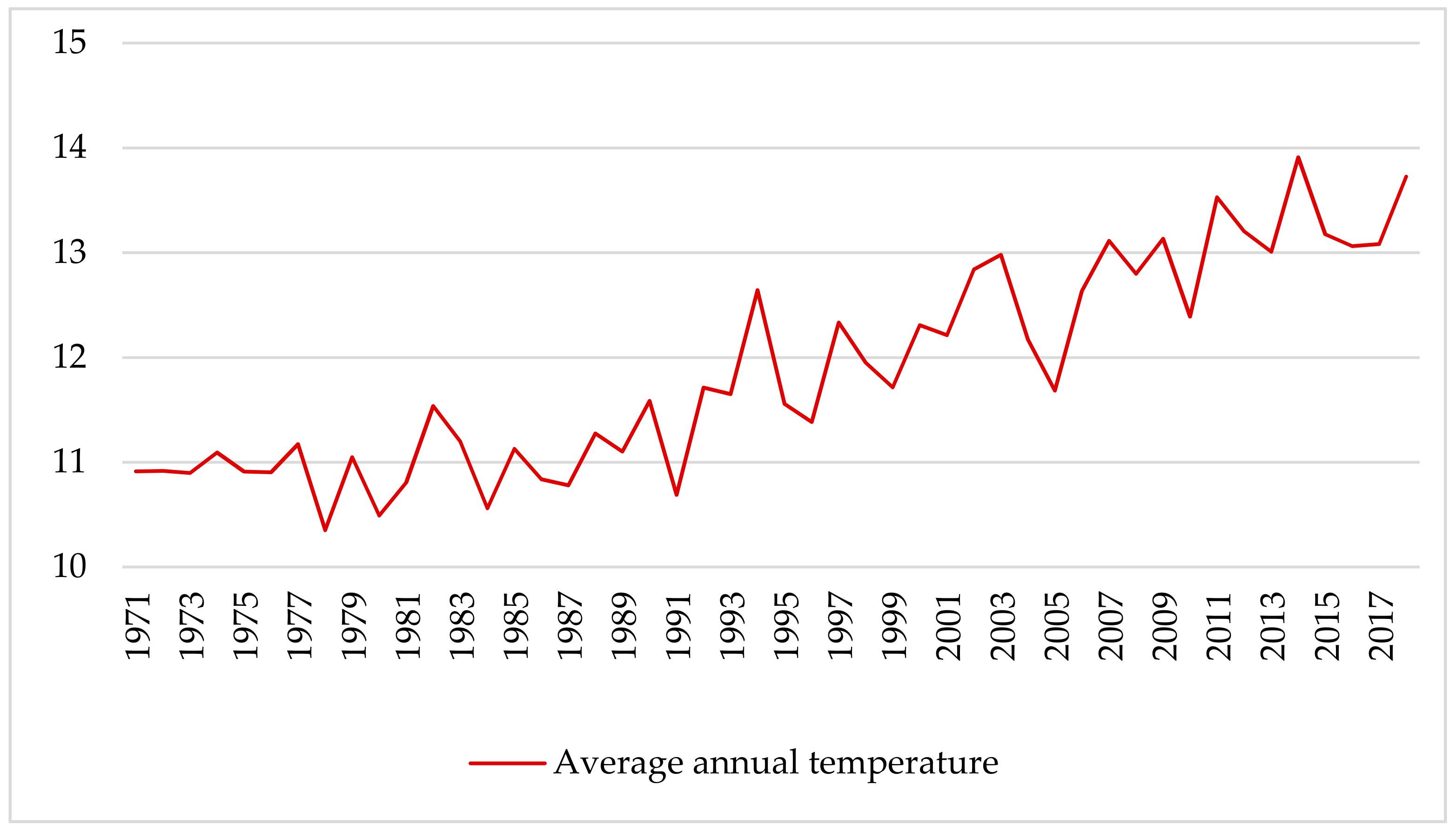
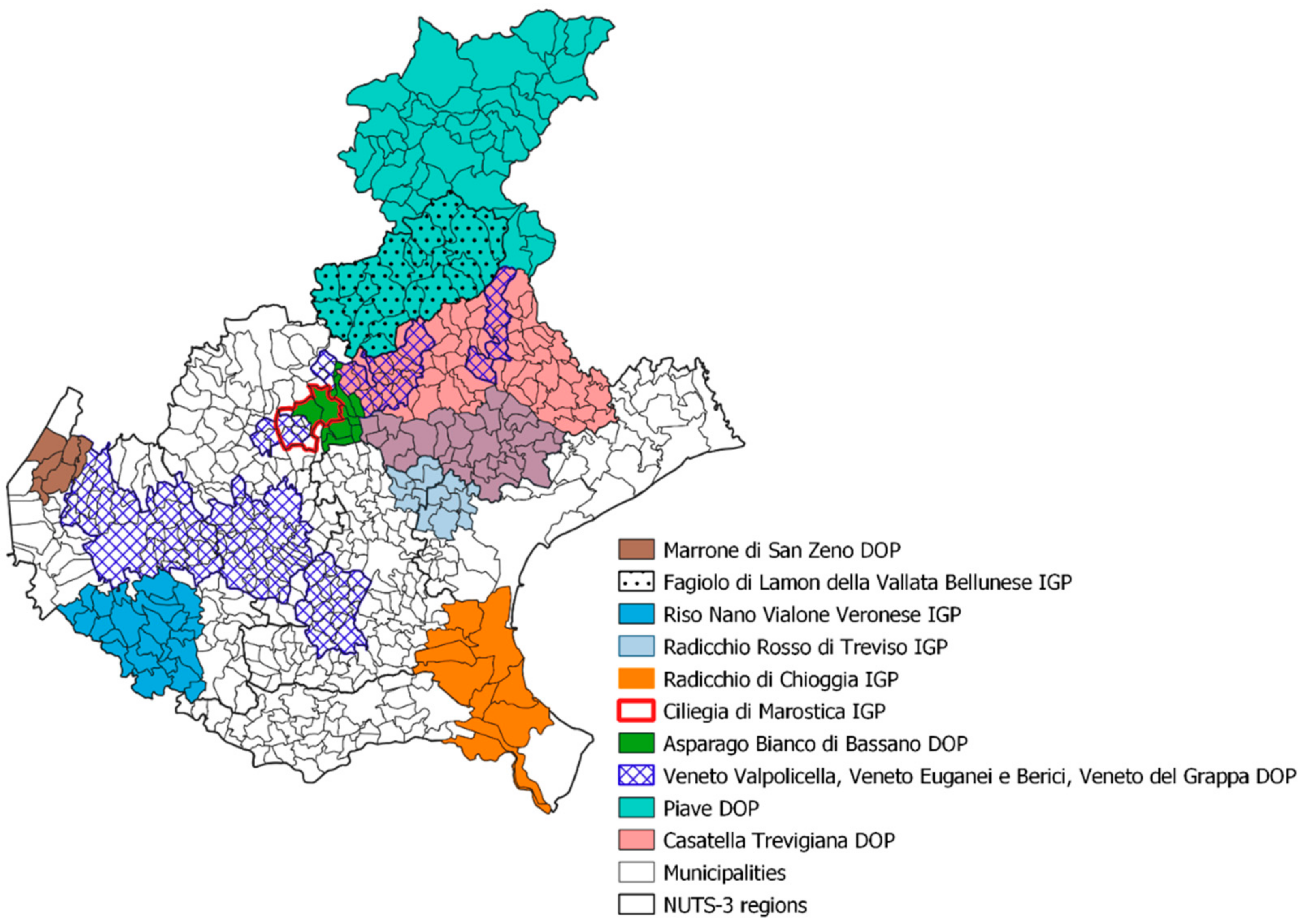
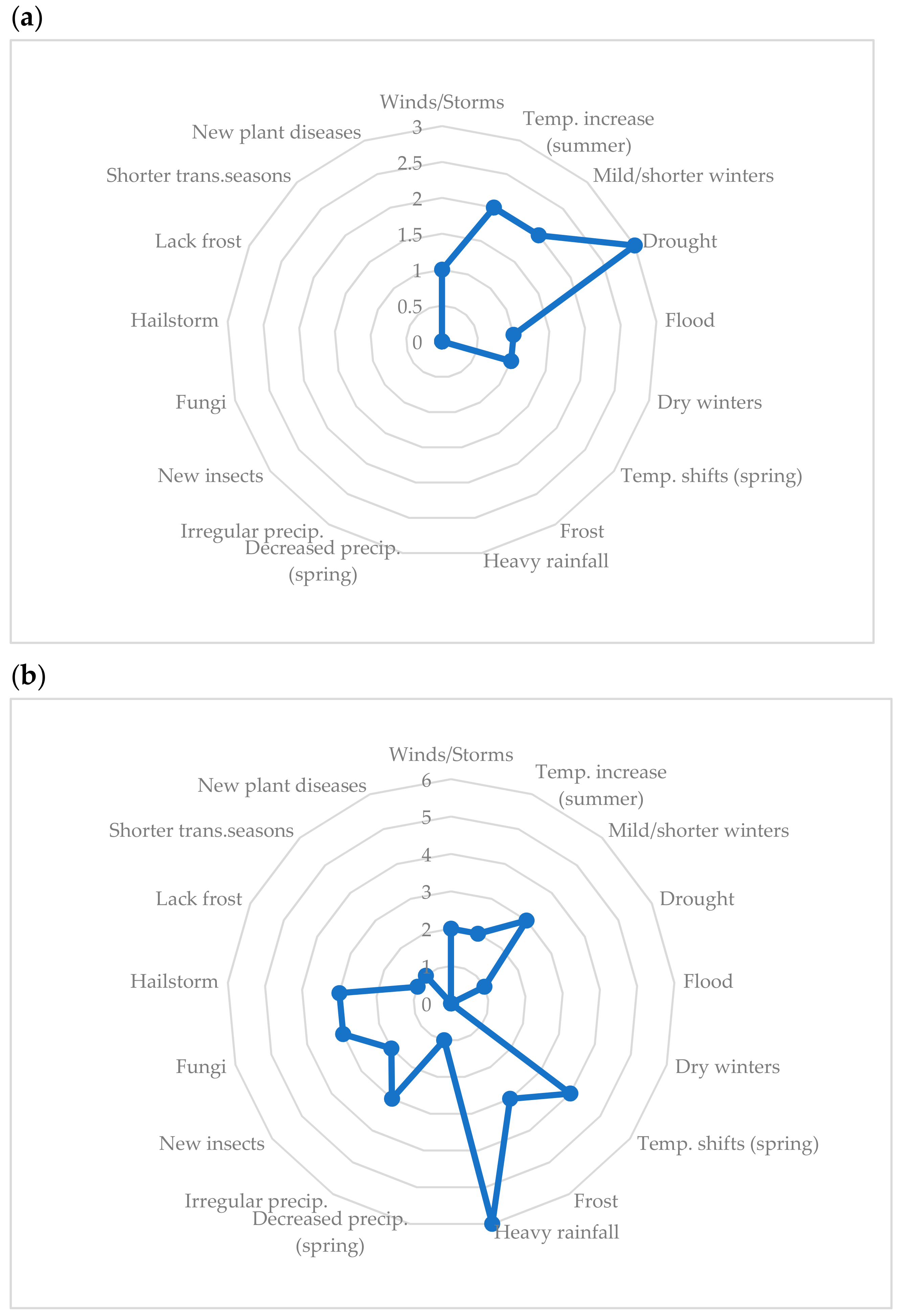
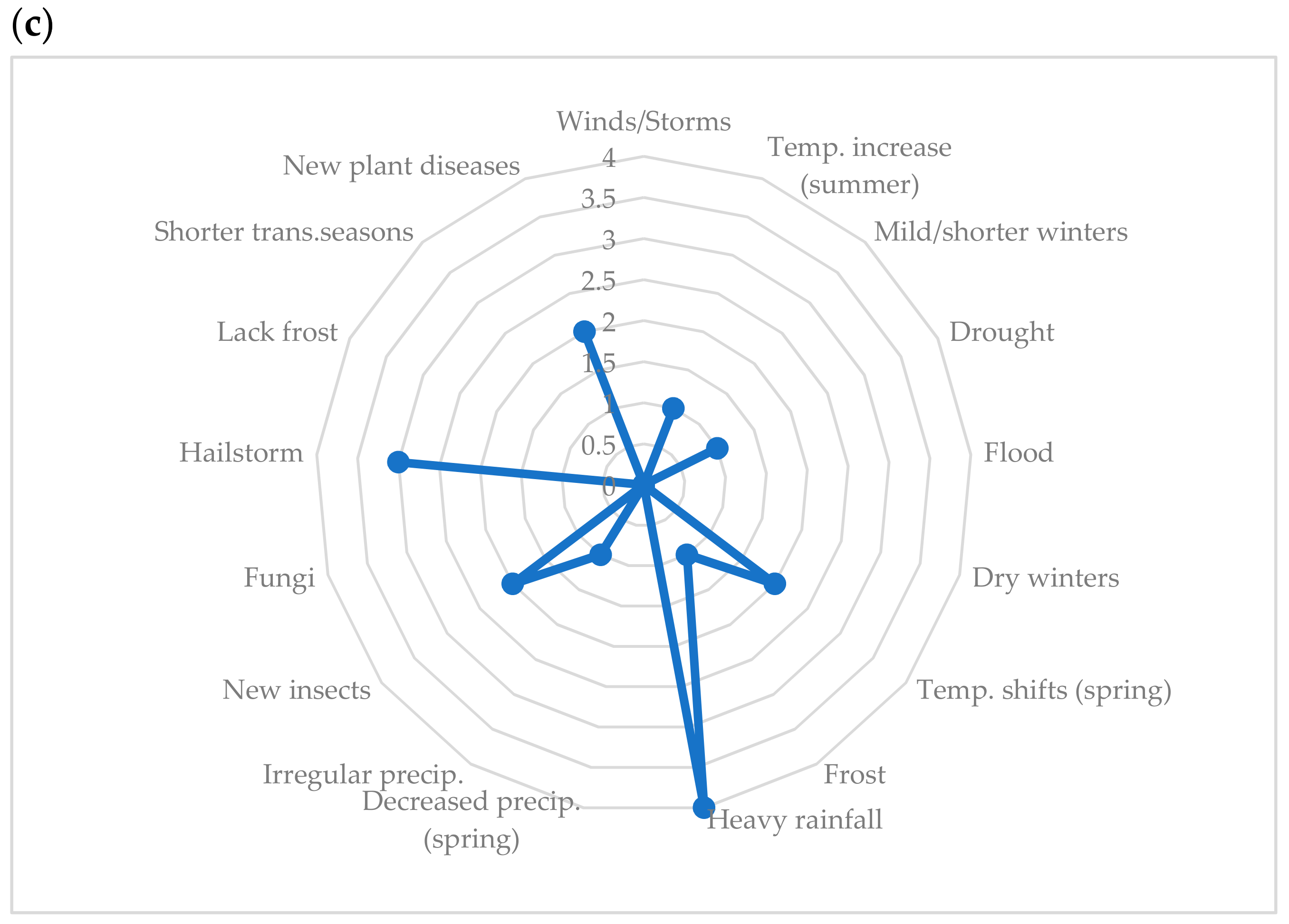
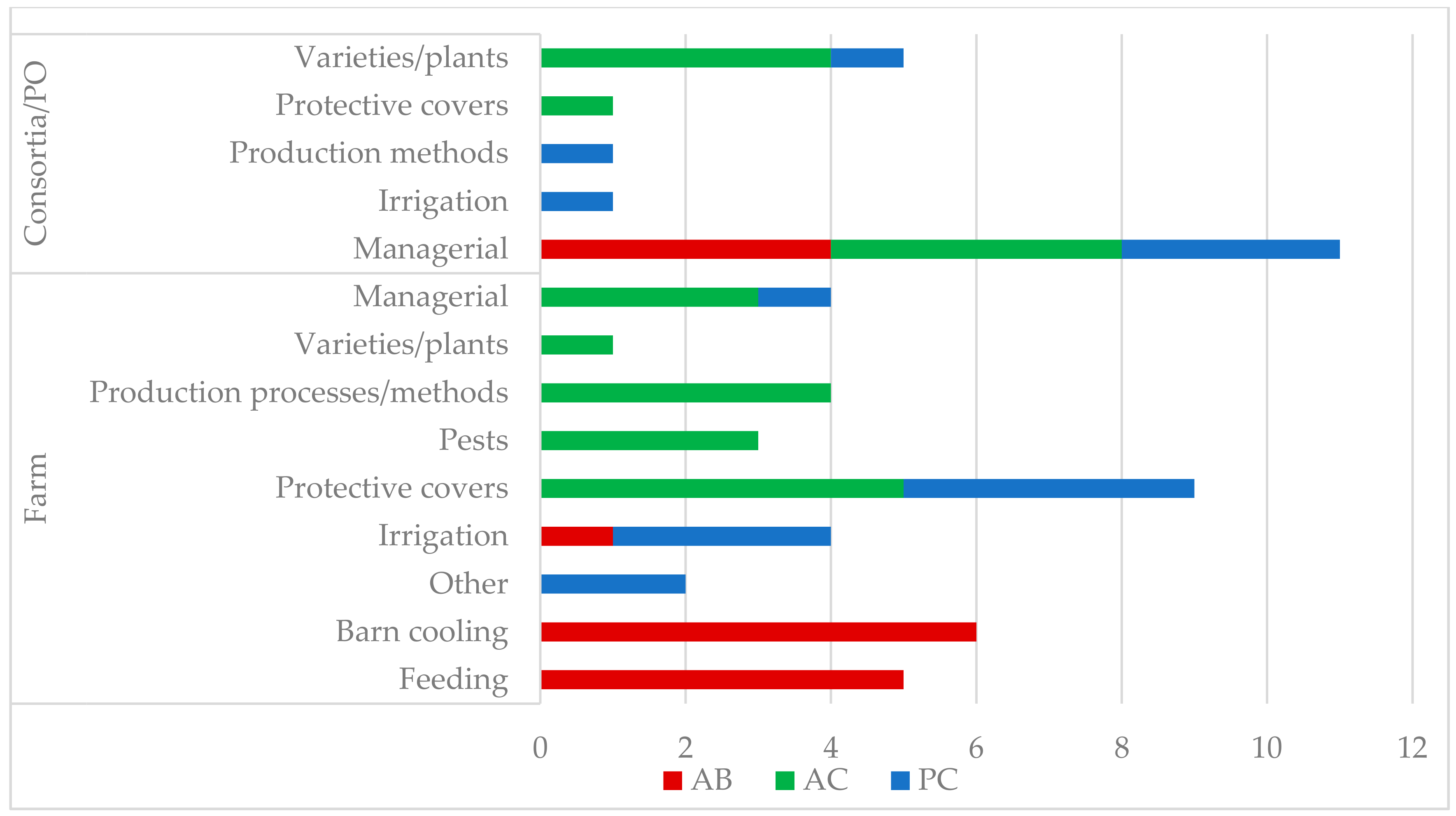
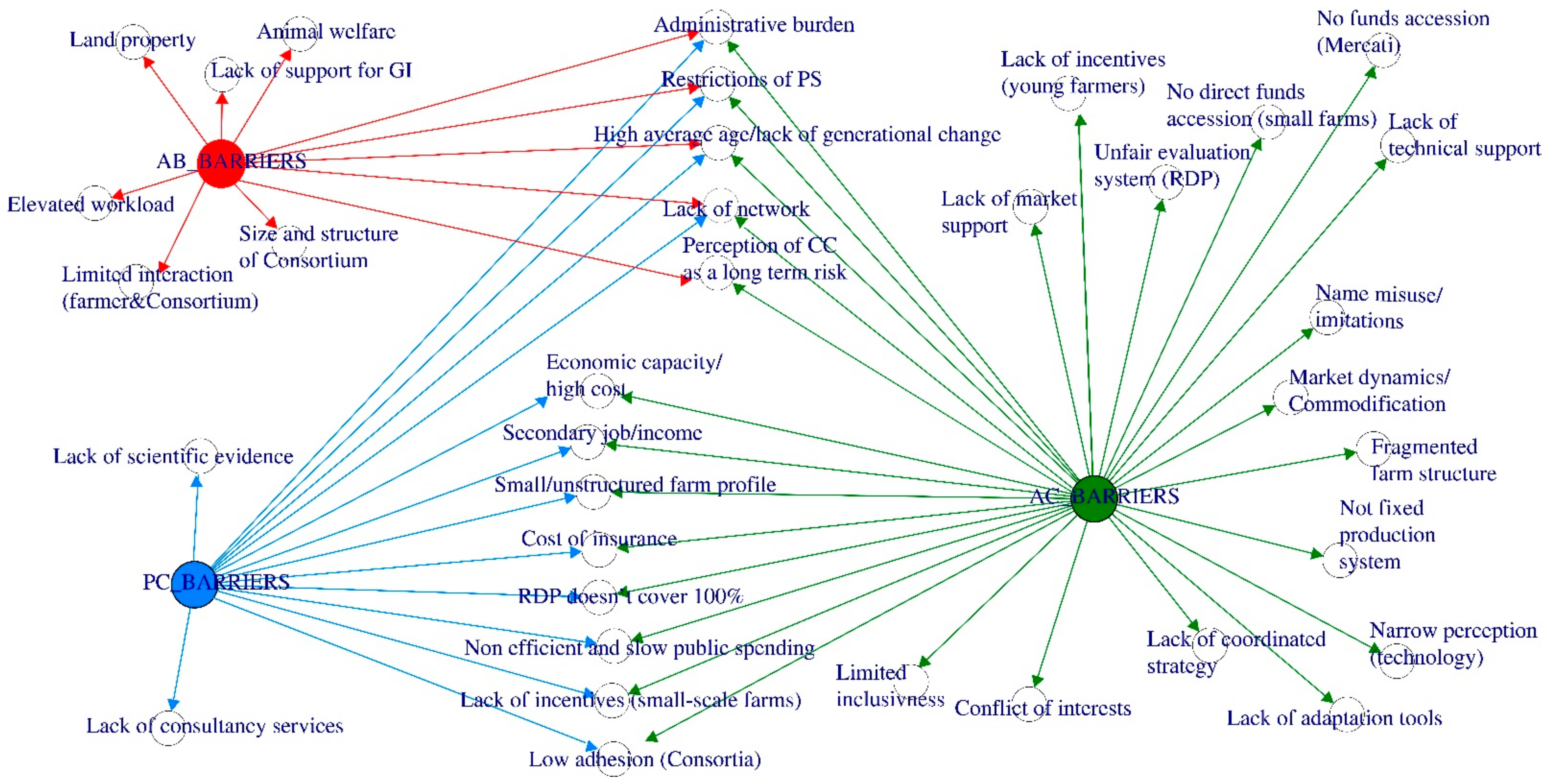
| Reference | Variable to Define Adaptation | Adaptation Categories | ||
|---|---|---|---|---|
| Incremental | Systems Adaptation | Transformational | ||
| [16] | Intensity of climate change impact | Low | Medium | High |
| [17] | Systems | Conventional systems | Certification (e.g., organic and GIs) | Integrated landscape systems |
| [17] | Complexity of implementation | Low | Medium | High |
| [15] | Continuance of change | Short-term | No information | Long-term |
| [14,15] | Complexity of alteration | Minor adjustments(“fine tune”) | No information | Fundamental changes |
| Clusters | Agri-Food GIs in the Veneto Region | ||
|---|---|---|---|
| Annual Crop | Permanent Crop | Animal Based | |
| Little revenue PDOs | Asparago Bassano | Garda oil, Marrone San Zeno | Prosciutto Veneto Berico Euganeo, Cozza Scardovari |
| Large-scale PDO cheeses | Grana Padano, Asiago, Monte Veronese, Taleggio, Montasio, Provolone | ||
| Second-generation PDOs | Aglio Bianco Polesano | Veneto Valpolicella olive oil | Salamini Cacciatora, Soppressa Vicentina, Miele Dolomiti Bellunesi, Casatella, Piave |
| Unexploited opportunities | Salami Cremona, Mortadella Bologna, Cotechino Modena, Zampone Modena | ||
| First-generation crop PGIs | Radicchio Verona, Radicchio Rosso Treviso, Fagiolo Lamon, Radicchio Variegato Castelfranco, Riso Nano Vialone Veronese | ||
| Second-generation crop PGIs with little revenue | Riso Delta del Po, Insalata Lusia, Radicchio Chioggia, Asparago Bianco Cimadolmo | Ciliegia Marostica, Asparago Badoere, Pesca Verona, Marrone Monfenera, Marrone Combai | |
| GI | Type * | Scheme a | Registration Year a | No. of Operators b | Production Area (Ha) b | Production Volume (kg/lt) c | ProductionCycle (Month of the Year) d |
|---|---|---|---|---|---|---|---|
| Asparago B. di Bassano (asparagus) | AC | PDO | 2007 | 56 | 14 | 40.0 | 03–06 |
| Ciliegia di Marostica (cherry) | PC | PGI | 2002 | 121 | 58 | 13.0 | 03–08 |
| Fagiolo di Lamon (bean) | AC | PGI | 1996 | 81 | 12 | 9.7 | 05–09 |
| Monte Veronese (cheese) | AB | PDO | 1996 | 140 | 3093 | 893.9 | 01–12 |
| Radicchio di Chioggia (chicory) | AC | PGI | 2008 | 32 | 97 | 124.8 | 12–07 |
| Radicchio R. di Treviso (chicory) | AC | PGI | 1996 | 114 | 303 | 894.6 | 06–12 |
| Riso Nano V. Veronese (rice) | AC | PGI | 1996 | 28 | 524 | 530.8 | 04–09 |
| Olio Veneto (olive oil) | PC | PDO | 2001 | 290 | 371 | 39.0 | 03–12 |
| Casatella Trevigiana (cheese) | AB | PDO | 2008 | 70 | 1427 | 314.3 | 01–12 |
| Piave (cheese) | AB | PDO | 2010 | 180 | NA | 1.583 | 01–12 |
| Marrone di San Zeno (chestnut) | PC | PDO | 2003 | 29 | 52 | 12.7 | 03–11 |
| Phase | Method | Sampling Strategy | Sample Size and Participants | Purpose | Timeframe | Tools for Data Analysis |
|---|---|---|---|---|---|---|
| I | In-depth semi-structured interviews | Purposive sampling | 14 key informants (Consortia/Producers Organizations) 6 annual crop GIs 6 animal-based GIs 2 permanent crop GIs | Collecting climate change observations and perceived effects on GI production; identifying the main adaptation practices (if any) and perceived barriers to adaptation. | June–November 2021 | RQDA (R studio) |
| II | Focus group discussions (FGD) | Convenience and snowball sampling | FGD #1: 4 participants from 4 animal-based GI systems; FGD #2:10 participants from 4 crop-based GI systems | Enhancing some of the key issues captured during phase I and the results of the individual interviews | December 2021–January 2022 | RQDA (R studio) |
| Interview ID * | Interviewee | Type of Entity | GI | Type of the Interview |
|---|---|---|---|---|
| IAC01 | Manager, producer | Consortium | PDO | face-to-face |
| IPC02 | Producer | Consortium | PDO | face-to-face |
| IAC03 | Manager, producer | Consortium | PGI | face-to-face |
| IPC04 | Manager, agrarian | Consortium and PO | PDO | face-to-face |
| IAC05 | Expert advisor | Consortium | PGI | video call |
| IAB06 | Manager | Consortium | PDO | video call |
| IAC07 | Manager | PO | PGI | video call |
| IAC08 | Manager | Consortium | PGI | phone call |
| IAB09 | Manager, producer | Consortium | PDO | phone call |
| IAC10 | Manager, producer | Consortium | PGI | email interview |
| IAB11 | Producer | Dairy factory | PDO | phone call |
| IAB12 | Manager, producer | PO | PDO | phone call |
| IAB13 | Manager | Consortium and PO | PDO | phone call |
| IPC14 | Manager, producer | Consortium | PDO | phone call |
| FGDs | FGD Participant ID * | Participant | Type of Entity | GI |
|---|---|---|---|---|
| FGD #1 | FGPC1 | Manager, Producer | Consortium | PGI |
| FGD #1 | FGPC2 | Producer | Farm | PGI |
| FGD #1 | FGPC3 | Manager | PO | PGI |
| FGD #1 | FGPC4 | Producer | Farm | PGI |
| FGD #1 | FGPC5 | Marketing | Consortium | PGI |
| FGD #1 | FGPC6 | Producer | Farm | PGI |
| FGD #1 | FGPC7 | Manager | Consortium, PO | PGI |
| FGD #1 | FGPC8 | Producer | Farm | PGI |
| FGD #1 | FGAC9 | Expert Advisor | Consortium | PGI |
| FGD #1 | FGAC10 | Manager producer | Consortium | PGI |
| FGD #2 | FGAB11 | Manager, producer | Consortium | PDO |
| FGD #2 | FGAB12 | Manager, producer | Consortium | PDO |
| FGD #2 | FGAB13 | Manager, producer | PO | PDO |
| FGD #2 | FGAB14 | Producer | Dairy factory | PDO |
Publisher’s Note: MDPI stays neutral with regard to jurisdictional claims in published maps and institutional affiliations. |
© 2022 by the authors. Licensee MDPI, Basel, Switzerland. This article is an open access article distributed under the terms and conditions of the Creative Commons Attribution (CC BY) license (https://creativecommons.org/licenses/by/4.0/).
Share and Cite
Salpina, D.; Pagliacci, F. Are We Adapting to Climate Change? Evidence from the High-Quality Agri-Food Sector in the Veneto Region. Sustainability 2022, 14, 11482. https://doi.org/10.3390/su141811482
Salpina D, Pagliacci F. Are We Adapting to Climate Change? Evidence from the High-Quality Agri-Food Sector in the Veneto Region. Sustainability. 2022; 14(18):11482. https://doi.org/10.3390/su141811482
Chicago/Turabian StyleSalpina, Dana, and Francesco Pagliacci. 2022. "Are We Adapting to Climate Change? Evidence from the High-Quality Agri-Food Sector in the Veneto Region" Sustainability 14, no. 18: 11482. https://doi.org/10.3390/su141811482
APA StyleSalpina, D., & Pagliacci, F. (2022). Are We Adapting to Climate Change? Evidence from the High-Quality Agri-Food Sector in the Veneto Region. Sustainability, 14(18), 11482. https://doi.org/10.3390/su141811482








